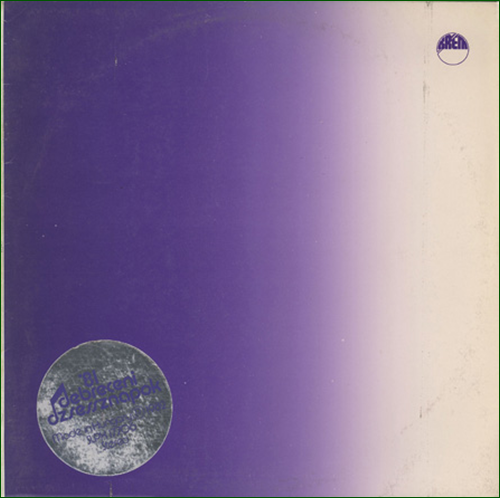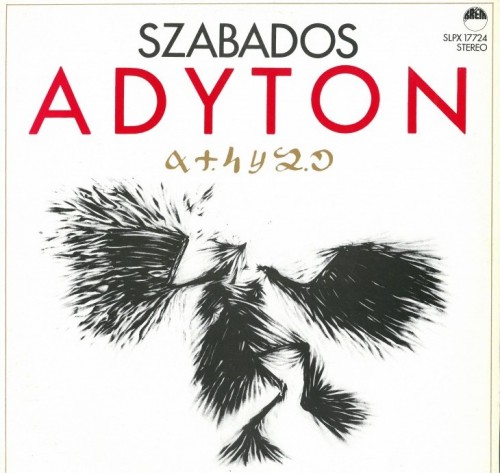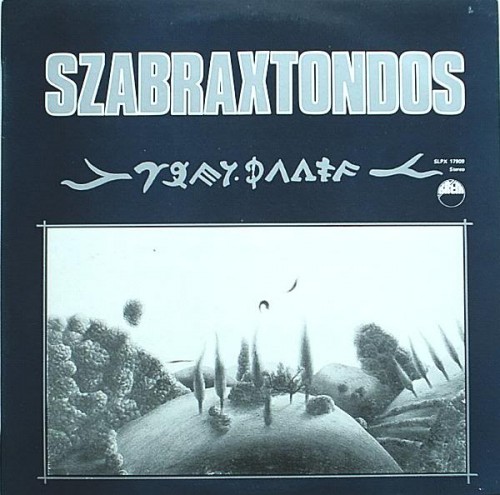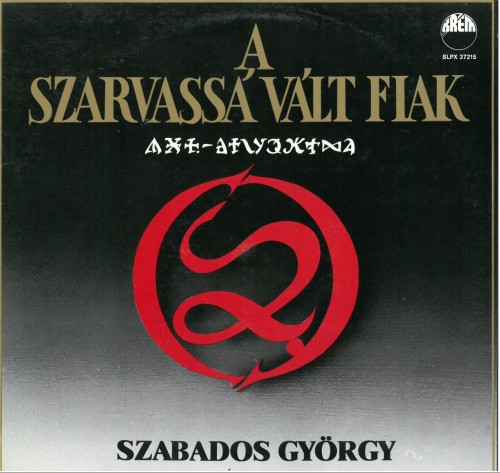1982:
Debreceni Dzsessznapok’81 (1981) – Hungaroton – SPLX 17706
1983:
Adyton (1982) – KREM SLPX 17724
LINER NOTES: 
LP Backside Text: Though affiliated to jazz in the first place, György Szabados is also an outstanding figure of Hungary’s musical and intellectual life. Born in 1939, he was among the few to help to develop jazz as an independent genre in Hungary. In 1972 his quintet won the renowned San Sebastian Jazz Festival Grand Prize.
read more...János Kőbányai
I am indebted to Mihály Dresch, István Fekete, Ferenc Körmendy and Antal Lakatos for their artistic contributions. Many thanks to Otto Tolnai, whose volume “Vilagpor” (World Dust) inspired my composition of the same title.
György Szabados
1985:
Szabraxtondos (1984) – KREM SLPX 17909
LINER NOTES: 
Text Inlet Page 1 & 2:
„To Revive a Dead Man to Dance”
„For Our Women”
„Bitter”
»szaBRAXTONdos”
This record provides evidence of the musical results from an extraordinary encounter, in which two musicians from different geographical and cultural regions have reached mutually inspiring cooperation.
read more....
Anthony Braxton has been a central figure in contemporary music for many years, and modern jazz traditions and developed composed music alike have influenced him. He began his activity in the Chicago musicians’ cooperative AACM, and first came to Europe in 1969, since when he has worked with many musicians from all parts of the world and with several bands of his own.
György Szabados holds a special position on the Hungarian jazz scene, since his aim is not to copy an imported jazz idiom but to develop an independent musical trend. With his „musical mother tongue” (folk music, Bartók, Kodály and the like) as his starting point, he has managed over long years of creative work to renew and expand a manner of musical expression in a way that resembles the effort of creative musicians throughout the world without surrendering its specific sources in any way.
So, origins and paths of development aside, Braxton and Szabados have several noteworthy features in common. Both are open to other musical cultures. To Braxton „world music” is no diluted blend, it is a live exchange of experiences with musicians from other countries and continents. Szabados has been concerned for a long time with Afro-American music, and Braxton is far from unfamilliar with the realms of Schoenberg and Bartók.
Szabados and Braxton have expressed their musical scope and ideas through both unaccompanied solos and ensemble work with other musicians. Although Braxton has more frequently changed his musical environment, he too has always retained his musical identity, His respect for the prevailing context in which he is working shows in his receptiveness to the initiatives of Szabados the composer, to which he adds his own influence and in doing so makes the pieces his own.
Braxton and Szabados arc examples of a new type of musician. Both compose, yet both are instrumentalists and improvisers as well. By integrating the methods of composition and improvisation, they have precluded any simplified labelling of their creative process. Each in his own way has developed a different yet comparable sense of form and construction in which spontaneity is never sacrificed to concept. Both are influenced by jazz, folk music and what is called serious music, but the results cannot be pigeonholed into conventional concepts.
Another, important feature in common is that both Braxton and Szabados elaborate their music through a lengtny process that involves for both a deep commitment and sincerity.
Szabados and Braxton first met in 1982 when they were performing in Györ, western Hungary. The following year the Braxton-Szabados duo played at the Daxberg festival in West Germany. Both wanted to keep up the acquaintanceship, and thanks to Hungarian Radio, they made a two-day studio recording in Budapest in 1984, and then appeared again as a duo at the jazz festival in Debrecen.
Their cooperation ranges from through-composed pieces („For Our Women”) to fully spontaneous interactions („szaBRAXTONdos”). In their works they break down the hegemony of the major-minor system (for instance by reaching back to pentatony or using chromatics), and concurrently they allow metric-rhythmic articulation to be eroded (among other means by parlando-rubato phrasing). The improvisations display a reliance on common reserves of material and a sense of responsibility directed at structural contexts. „Bitter” (Keserves) is a perfoming direction denoting also a group of Hungarian folksong laments that links in an unspoken way a plaintive mood with a sense of hope. (Thus in the widest sense there is a kinship between the keserves and the remote realm of the blues). „To Revive a Dead Man to Dance” revolves in terms of content around a Tibetan rite in which the dead man is urged to dance by the kiss (and the will-power) of a living man. But if the energy and concentration prove insufficient, thc living man is sacrificed to the dead.
Disregarding their extra-Musical content, these tracks of the two playing together radiate a rare interweaving of lyricism and purposefulness. As documents of a musical encounter, punctiliously elucidating the intellectual and intuitive features that two musicians have in common despite the different paths of development they have trodden, they certainly have a significance that goes beyond the immediate.
Bert Noglik
1989:
The Sons Turned into Stags – A szarvassá vált fiak (1985) -Krém SLPX 37215
LINER NOTES: 
Text Inlet Page 1:
The music of The Sons Turned Into Stags was commissioned by ballet director Iván Markó, choreographer, in the fall of 1984, for his troupe Györi Balett (Ballet of Györ). The single act music piece was completed by the end of January 1985 and was recorded in studio 22 of the Hungarian Broadcasting Company in March, with Johannes Bauer, Mihály Dresch Dudas, Antal Lakatos and György Szabados as soloists and the extended MAKUZ Orchestra conducted by the composer.
read more....Here the story is irrevocably dramatic, both individually and communally. The sons having stepped out once in the surrounding world with pure heart are now facing challenged by the demons of helplessness and desperations. Withered peace and suicidal “holy” war, deadly modernness and lost past, self-preserving hatred, coward violence and panicky cult of pleasure are opposed in them: parts that won over the Whole. It is the symbiosis of stupid sorcerer’s apprentices and jealous satanlets, all greedy and incapable. Outside, a declining, wild bereft of the spint world, in which the great answer of the irrationality of Nature is prepared behind the fake lavishness of the scenes, inconspicuously and mysteriously….
But deep in this painful myth the life and death of cultures is also at stake in the triple fate of the sons. Choises and ways. Deadly devouring of selfish and unlimited licence (eldest son), the illusion of power and the successive apocalypse (second son), and the fate of the youngest son, who heeds to his heart’s calling but after his borther’s fall he is longing for his mother’s goodness desperately and in vain – there is no way lack for him either. Problems are always the same, timeless and unavoidable.
Man has to save himself first. Suffering again the miracle of existence, submerging in its deep inner lakes, he will have to take the Whole World in his heart and artistic soul. He will have to find himself to unite with the Whole, to form a union with the Gods.
The musical texture of the piece is extremely loose and open, the rhythm is relative, yet the style is strict and the aspiration is to be unambiguously understood. The performance requires the creative cooperation of musicians of the new school.
The ballet has first staged on August 18, 1985 at the Szeged Open Air Festival. The music was performed at a concert of the Budapest Spring Festival, In Petöfi Hall, on March 21, 1988.
György Szabados
Text Inlet Page 2:
Listening to The Sons Turned Into Stags
It hath been said the soul is Chaos
And Dante’s descent in Hell is but
Diving into the dark realm of Chaos.
The Lord’s ears are filled with silence.
The response of my dark shell’s ivory keyboard resounds in me to the calling beast of His eardrum.
On the road.
Deep clarion carry me away; then I am overwhelmed by sweeping mystery.
My brass-sounding self is fighting, I am enclosed in the troubled dance of sensations I am amissionary of fire.
Toll, death knell, toll till red-hot; for the screaming struggle of the brass is without avail, no use in the droning of dimness; the giant trap of clapping strings tosses me into silence.
Yet this is Silence, its first stage where the heart hears the piping birdsong of Heavenly Peace. I say silence; but this silence the frail rhythm of desire feed the seed to grow into sword blade grass…
The gates of the secret open, the soul steps forth and reveals itself to the Unknown.
Wells spurt out.
A farewell to the wounds of vanity, the clay encasement of the sould is torn open by long-forgotton sighs of its magma.
A breeze of farewell and a prayer.
The reconciliation of acceptance.
Then silence again.
The roaring happy feast of belonging peals forth, the ephemeral dance of joy flares up, then beneath it: the depth of fearful beginning calling, calling…..
The orchestra of the Lord is playing.
Move on, you tortured heart from the field of the Good mistakenly thought obtained: this is just a mirage. Set out on your last journey to the bright unknown. Carried away by gloomy Styx, vulnerably… The ivory keyboard of Desperation tolls in vain for you, all is covered, hidden by the last drought.
There is no return from here, only the Creator can decide who will survive His hammer.
Only a soul hotter than the melting pot of this furnace can survive; only if you give yourself up can you escape from the grasp of horror.
You can hear the breathing of the Lord…
And before the light of the Spirit shine up, the horrific stream of Darkness breaks through, the omnipotent law of Chaos would carry away everything, and in the rub-a-dub of the drummers of purgatory beating on your skin the mask of lies will burn on your face.
Stop!
Tear off your face” Wake up, Man! Your brass voice should ring clearly! Throw away the tentacles of falseness, else there is nothing any more. Step over your minute of existence, for the gate of Nothingness is but a step away. Heave yourself up where winds are not made of brass but of clear breath. Leave your frozen cocoon, take off your snake skin!
Do not break, heart, now at the end. Wail over what remained after us: the pool of suffering and sorrow.
You have reached the realm of the Spirit.
You are home here, you can be the most: the dust of Nothingness, bright speck of dust floating in a lightbeam – my son who has become a deer.
Stay and go on, Space is calling and keeping you, endless and eternal.
And this M U S I C.
Zoltán Bicskei



